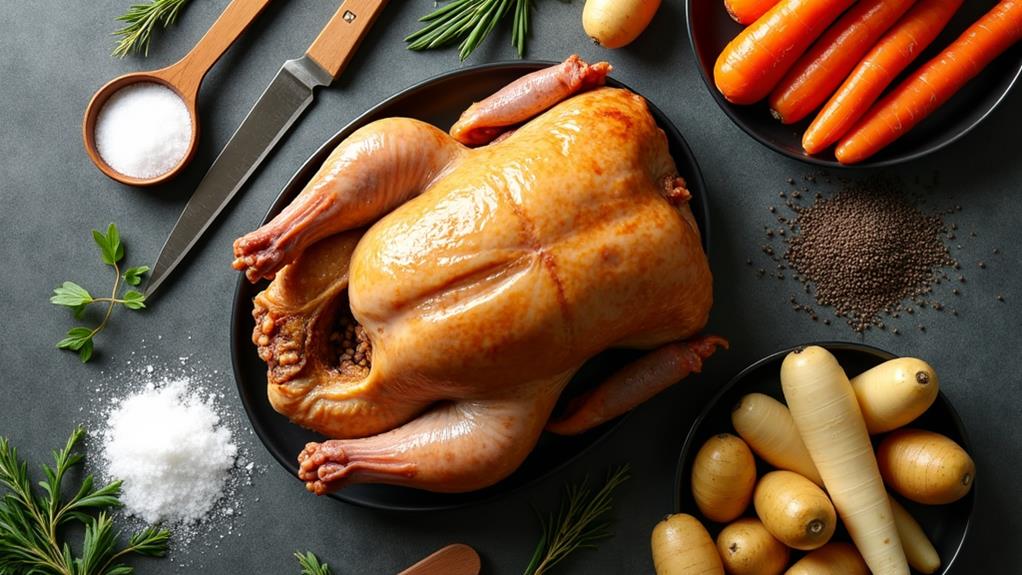When you think of festive feasts, roasted goose often comes to mind, doesn't it? This dish, steeped in history, isn't just about flavor; it symbolizes abundance and celebration. You might wonder how a simple bird can transform an occasion into something memorable. The key lies in the preparation techniques and seasoning that elevate it from ordinary to extraordinary. But what are the secrets behind achieving that perfect crispy skin and succulent meat? Let's explore the nuances that make roasted goose a timeless centerpiece.
Key Takeaways
- Roasted goose is a festive dish with a rich history, often served during Christmas and special occasions.
- Proper seasoning and drying the goose are essential for achieving crispy skin and tender meat.
- Roast the goose at 325°F for 2 to 2.5 hours, monitoring internal temperatures for doneness.
- Adding root vegetables halfway through roasting enhances flavor, utilizing the rendered goose fat.
- Allow the goose to rest for 30 minutes post-roasting to retain juices and improve flavor.
History
Roasted goose has a rich history that intertwines with festive traditions across various cultures. You might be surprised to learn that this traditional dish has graced tables during special occasions for centuries.
In medieval England, goose was a star player at the Christmas feast, symbolizing prosperity and abundance. Imagine gathering with family, sharing a beautifully roasted goose alongside other meats—what a treat!
The origins of roasting goose trace back to ancient Rome, where it was celebrated as a delicacy in lavish banquets.
Fast forward to today, and you'll find that many cultures still honor this festive bird. For instance, in Germany, the Feast of St. Martin on November 11th features roasted goose as a centerpiece, reflecting the bounty of the harvest season.
As preparation methods have evolved, cooks have embraced techniques like dry-brining and steaming, which enhance flavor and tenderness.
This innovation shows that while roasted goose has a storied past, it continues to adapt and thrive in modern kitchens.
Recipe

Roasted Goose
Roasting a whole goose is a delightful way to impress family and friends during festive occasions or special gatherings. With its rich flavor and succulent meat, a well-cooked goose can be the centerpiece of a memorable meal.
Prior to cooking, it's vital to prepare the goose by seasoning it generously and allowing it to dry in the refrigerator, which contributes to its crispy skin. This recipe outlines a straightforward process to achieve that perfectly roasted goose.
To begin, verify that your goose is properly thawed if it was previously frozen. Pricking the skin of the goose allows the fat to render out during roasting, leading to a beautifully crispy exterior. After seasoning the bird, roasting it at the correct temperature is key to achieving the desired doneness while keeping the meat juicy and flavorful.
Follow these steps for a delicious roasted goose that will leave everyone asking for seconds.
Ingredients:
- 1 whole goose (approximately 12 pounds)
- Kosher salt
- Black pepper
- Optional: herbs (such as thyme or rosemary) for additional flavor
- Root vegetables (such as carrots, potatoes, and parsnips) for roasting
Cooking Instructions:
Start by preheating your oven to 325°F. Season the goose generously with kosher salt and black pepper, rubbing it into the skin thoroughly.
Prick the skin all over with a sharp knife or fork to allow the fat to escape during roasting. Place the goose on a rack in a large roasting pan and roast in the preheated oven for approximately 2 to 2.5 hours, or until the internal temperature reaches 165°F in the thighs and 140-150°F in the breast for medium-rare doneness.
About halfway through cooking, you can add root vegetables to the roasting pan, tossing them in the rendered fat for added flavor. Once cooked, remove the goose from the oven and let it rest for 30 minutes before carving.
Extra Tips:
For the best results, consider brining the goose overnight or using a dry rub to enhance its flavor further.
Make sure you have a meat thermometer on hand to accurately check the internal temperature, as this is vital for achieving the desired doneness. Additionally, saving the rendered fat can be a great way to enhance other dishes, such as roasted potatoes or sautéed greens.
If you want to add a touch of sweetness, glaze the goose with a honey or fruit-based sauce during the last 30 minutes of roasting.
While roasted goose is a classic dish, other variations include preparing it with different herb blends or serving it with various sauces, such as a fruit compote or a rich gravy.
Similarly, dishes like duck or roast chicken can offer similar flavors and cooking methods, making them great alternatives to explore.
Final Notes
After enjoying your beautifully roasted goose, there are a few final notes to contemplate that can enhance your experience.
First, don't rush the resting time; let your goose rest for 30 minutes before carving. This step is essential for retaining those delicious juices and boosting the overall flavor.
Keep an eye on the internal temperature during roasting. Aim for 165°F in the thighs and around 140-150°F in the breast meat for perfect doneness. You'll love the crispy skin that results from paying attention to these details!
When you're cooking vegetables to accompany your roast, consider using the rendered goose fat. It adds a rich flavor and serves as a healthier alternative to butter, elevating your dish to new heights.
For a burst of flavor, stuff the cavity of the goose with garlic cloves and your favorite aromatics before roasting.
And don't forget about the carcass! Save those bones to prepare a rich goose stock. This will be a fantastic base for soups or sauces, ensuring you savor every bit of your culinary creation.
Enjoy the feast and all the wonderful flavors that come with it!
